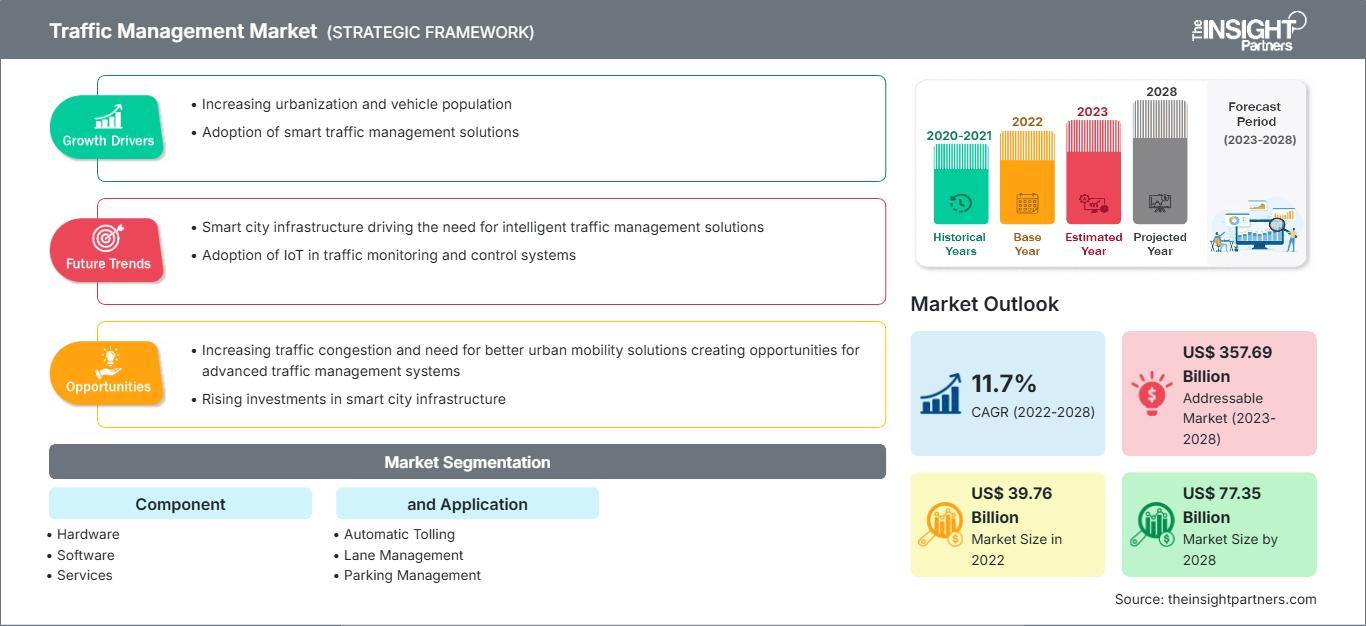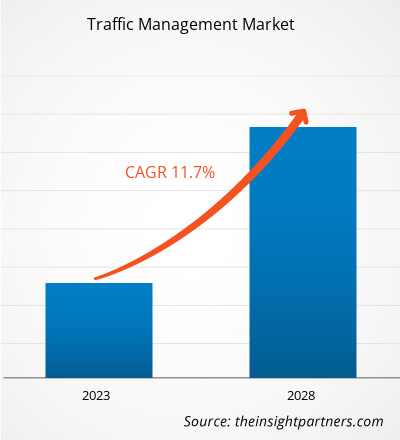교통 관리 시장은 2022년 397억 5,674만 달러에서 2028년 773억 4,644만 달러로 성장할 것으로 예상되며, 2022년부터 2028년까지 연평균 11.7% 성장할 것으로 예상됩니다.
대부분의 국가에서 수년간 급격한 도시화가 진행되어 복잡한 도로망과 심각한 교통 체증이 발생했습니다. 도시 인구 증가와 자가용 소유 증가로 인해 도로 위 차량 수가 증가했습니다. 인도 뭄바이의 인구는 2011년 1,850만 명에서 2020년 2,040만 명으로 증가했으며, 이 기간 동안 자가용 차량 수는 거의 두 배로 증가했습니다. 이러한 요인들과 이를 개선하기 위한 노력으로 교통 관리 시장은 성장할 것으로 예상됩니다. 또한 Uber, Grab, Ola, Lyft와 같은 택시 호출 서비스가 빠른 속도로 증가하고 있습니다. 이러한 서비스는 대중교통 시스템을 대체하여 도로 위 차량 급증으로 이어졌습니다. 이러한 요인으로 인해 정부 당국은 효과적인 솔루션을 위해 교통 관리 시장 참여자에게 접근하고 있습니다. 소프트웨어, 센서, 카메라 및 디스플레이 보드로 구성된 강력한 교통 관리 시스템을 통해 교통 체증을 효과적으로 줄일 수 있습니다. 이러한 시스템은 인프라 개조 없이 기존 도로에 설치할 수 있습니다. 마찬가지로 차선 관리 시스템은 각 시점의 교통량에 따라 차선을 열거나 닫아 교통 흐름을 효과적으로 관리할 수 있습니다. 교통 관리 시스템이 제공하는 이점을 고려할 때, 빠른 도시화 속도는 교통 관리 시장 규모를 크게 확대할 것으로 예상됩니다.
COVID-19 팬데믹이 교통 관리 시장 성장에 미치는 영향
COVID-19 발생은 자동차, 제조, 에너지 및 전력, 항공우주 및 2020년 국방, 건설. 코로나19 확진자 수의 지속적인 증가로 인해 미국을 비롯한 여러 국가의 정부 당국은 2020년 1~3분기 동안 엄격한 봉쇄 조치를 시행해야 했습니다. 이로 인해 모든 국가에서 교통량이 크게 감소했습니다. 무역 금지, 여행 제한, 인력 감축과 같은 봉쇄 조치는 교통 관리 하드웨어, 소프트웨어 및 서비스 제공 업체를 포함한 다양한 기업의 제조, 공급 및 판매 활동에 영향을 미쳤습니다. 제조업은 일시적인 공장 가동 중단과 생산량 감소로 심각한 손실을 입었고, 이는 교통 관리 하드웨어 시스템 생산에도 차질을 빚었습니다. 미국에서는 연방 정부와 주 정부가 팬데믹 대응에 더욱 집중하면서 교통 관리 하드웨어 및 소프트웨어 설치가 일시적으로 중단되었습니다. 유럽 교통 관리 산업은 인프라 프로젝트 지출이 약 20% 감소하여 심각한 타격을 입었고, 이로 인해 여러 스마트 시티 및 스마트 도로 프로젝트가 지연되거나 중단되었습니다. 반도체 가격 상승과 공급망 차질은 상황을 더욱 악화시켰습니다. 그러나 교통 관리 시장은 2020년 4분기에 긍정적인 성장을 경험하기 시작했습니다.
이 보고서의 일부, 국가 수준 분석, Excel 데이터 팩을 포함하여 모든 보고서에 대한 사용자 정의를 무료로 받을 수 있을 뿐만 아니라 스타트업 및 대학을 위한 훌륭한 제안 및 할인을 이용할 수 있습니다
교통 관리 시장: 전략적 통찰력

- 이 보고서의 주요 주요 시장 동향을 확인하세요.이 무료 샘플에는 시장 동향부터 추정 및 예측에 이르기까지 데이터 분석이 포함됩니다.
시장 분석 - 교통 관리 시장
전 세계적으로 커넥티드 기기의 폭발적인 성장이 예상되며, 여러 국가에서 스마트 시티 개발에 투자하고 있습니다. 스마트 시티는 다양한 센서와 전자 기술을 활용하여 데이터를 수집하고 지역 사회 발전에 활용하는 기술적으로 진보된 도시입니다. 스마트 시티는 교통 및 물류 최적화와 교통 체증 감소를 통해 교통을 관리하기 위한 장기적인 계획을 바탕으로 설계되었습니다. 따라서 스마트 시티와 더불어 각국에서는 더욱 안전한 차량 통근을 위한 스마트 도로 개발에도 투자하고 있습니다. 스마트 도로에서는 다양한 유형의 센서와 하드웨어가 교통량 모니터링에 사용되는 다변량 데이터를 수집합니다. 이 데이터는 도로를 주행하는 차량과도 공유되어 운전자와 통근자가 정보에 기반한 결정을 내릴 수 있도록 지원합니다. 따라서 스마트 시티와 스마트 도로의 도입 증가는 교통 관리 시장 규모 확대로 이어질 것으로 예상됩니다.
구성 요소 기반 분석
교통 관리 시장은 구성 요소, 애플리케이션, 그리고 지리적 위치를 기준으로 세분화됩니다. 시장은 구성 요소별로 하드웨어, 소프트웨어, 서비스로 세분화됩니다. 하드웨어 시장은 카메라, 디스플레이 보드, 센서로 더 세분화되고, 소프트웨어 시장은 클라우드와 온프레미스로 나뉩니다. 여러 정부 기관이 교통 관리 하드웨어 업그레이드에 투자해 왔습니다. 도시화의 진전과 자동차 소유 증가는 도시 도로에 부담을 주고 있습니다. 따라서 관계 당국은 교통 흐름 유지 및 안전 확보를 위해 최신 카메라를 활용하고 있습니다. 자동 번호판 인식(ANPR) 카메라는 위반자 식별 또는 사고 조사 중 차량 위치 파악을 위해 점점 더 많이 사용되고 있습니다. 이 카메라는 종종 차량 속도를 측정하기 위해 레이저 센서와 함께 사용됩니다.
응용 분야별로 교통 관리 시장은 자동 요금 징수, 차선 관리, 주차 관리, 감시, 교통 신호 관리 등으로 세분화됩니다. 지리적으로 볼 때 시장은 주로 북미, 유럽, 아시아 태평양(APAC), 중동 및 아프리카(MEA), 남미(SAM)로 구분됩니다. IBM Corporation, Cisco Systems, Inc., Siemens AG; Hangzhou Hikvision Digital Technology Co., Ltd.와 Dahua Technology Co., Ltd.는 교통 관리 시장의 주요 기업 중 일부입니다.
교통 관리 시장 지역별 통찰력
The Insight Partners의 분석가들은 예측 기간 동안 교통 관리 시장에 영향을 미치는 지역별 동향과 요인들을 면밀히 분석했습니다. 이 섹션에서는 북미, 유럽, 아시아 태평양, 중동 및 아프리카, 그리고 중남미 지역의 교통 관리 시장 부문 및 지역별 현황도 살펴봅니다.
교통 관리 시장 보고서 범위
| 보고서 속성 | 세부 |
|---|---|
| 시장 규모 2022 | US$ 39.76 Billion |
| 시장규모별 2028 | US$ 77.35 Billion |
| 글로벌 CAGR (2022 - 2028) | 11.7% |
| 이전 데이터 | 2020-2021 |
| 예측 기간 | 2023-2028 |
| 다루는 세그먼트 |
By 구성 요소
|
| 포함된 지역 및 국가 | 북미
|
| 시장 선도 기업 및 주요 회사 프로필 |
|
교통 관리 시장 참여자 밀도: 비즈니스 역학에 미치는 영향 이해
교통 관리 시장은 소비자 선호도 변화, 기술 발전, 그리고 제품 이점에 대한 인식 제고 등의 요인으로 인한 최종 사용자 수요 증가에 힘입어 빠르게 성장하고 있습니다. 수요가 증가함에 따라 기업들은 제품 및 서비스를 확장하고, 소비자 니즈를 충족하기 위한 혁신을 추진하며, 새로운 트렌드를 적극 활용하고 있으며, 이는 시장 성장을 더욱 가속화하고 있습니다.

- 을 얻으세요 교통 관리 시장 주요 주요 플레이어 개요
교통 관리 시장 참여자들은 주로 첨단 고효율 제품 개발에 집중하고 있습니다.
- 2021년, 다화테크놀로지(Dahua Technology)는 영상 감시 기술과 AI, ANPR, 이미지 퓨전, AR 및 기타 첨단 기술을 결합하여 현대 교통 단속 부서의 다양한 요구를 충족하는 종합적인 스마트 교통 관리 솔루션 개발을 발표했습니다.
- 2021년, 카메라 전문 IoT 솔루션 제공업체인 하이크비전(Hikvision)은 도로 안전 및 교통 흐름 개선을 위한 최신 교통 제품인 '올 라운더(All-Rounder) ITS 카메라'를 출시했습니다. 이 카메라는 속도 감지, 교통 위반 감지, 자동 번호판 인식, 차량 속성 분석 등 다양한 기능을 하나의 패키지로 제공합니다.
- 과거 분석(2년), 기준 연도, CAGR을 포함한 예측(7년)
- PEST 및 SWOT 분석
- 시장 규모 가치/거래량 - 글로벌, 지역, 국가
- 산업 및 경쟁 환경
- Excel 데이터세트
최근 보고서
관련 보고서
사용 후기
구매 이유
- 정보에 기반한 의사 결정
- 시장 역학 이해
- 경쟁 분석
- 고객 인사이트
- 시장 예측
- 위험 완화
- 전략 기획
- 투자 타당성 분석
- 신흥 시장 파악
- 마케팅 전략 강화
- 운영 효율성 향상
- 규제 동향에 발맞춰 대응






















 무료 샘플 받기 - 교통 관리 시장
무료 샘플 받기 - 교통 관리 시장